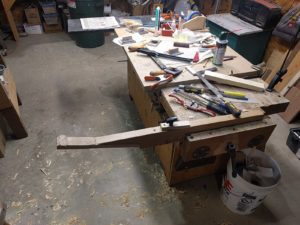Chips and sawdust on the floor. Bench covered with files, rasps, spokeshaves, sandpaper and other bits. Must be neck shaping time. Three out the four for this group are done, sanded to 220 grit. One more to go. Next I’ll add the 2mm pearl side dots. Then I’ll seal the surface with either shellac or CA glue (have not decided which yet), re-sand off any rough spots, and things are pretty much ready for finishing.
What’s with the pearl dot on the back of one of the necks you might ask (if you are observant). Well, that is a response to a little problem. I was sanding down the neck, nearing the final 220 grit sanding. I noticed a little dark spot, the size of a pencil point. “A little pin knot” I thought to myself, I’ll just sand it out. As I sanded a little further the spot got bigger. Then I realized it was not a spot, but rather a hole! There was a little bug hole deep in the middle of the wood. Some how this is appropriate, since this is the neck for the ambrosia maple body. Ambrosia maple is caused by burrowing beetles, and one has to patch up the bug holes in Ambrosia maple too.
The neck is fine other than one small bug hole I tried filling the hole, but that still left a darker spot, right in the middle of things. So I decided to drill out around the hole, and apply a white pearl dot, which matches the dots on the fretboard. I have done this once before, when working on a banjo neck, and I sanded down to a blemish in the wood which was just going to always bother me. So I did a little abalone inlay on the back of that banjo neck. One can admit to the vulgarities of wood (and insects) but still make something nice looking.

